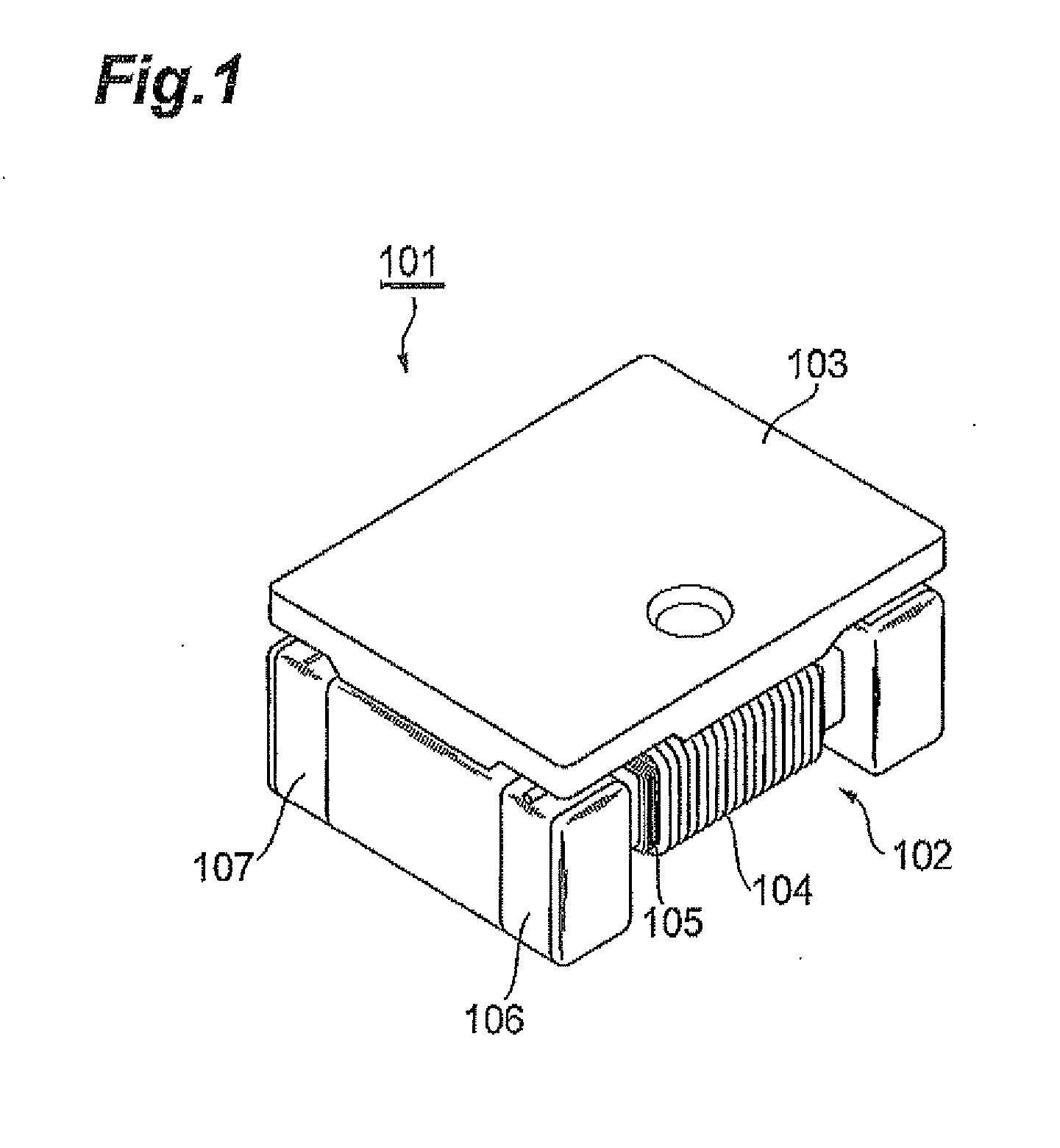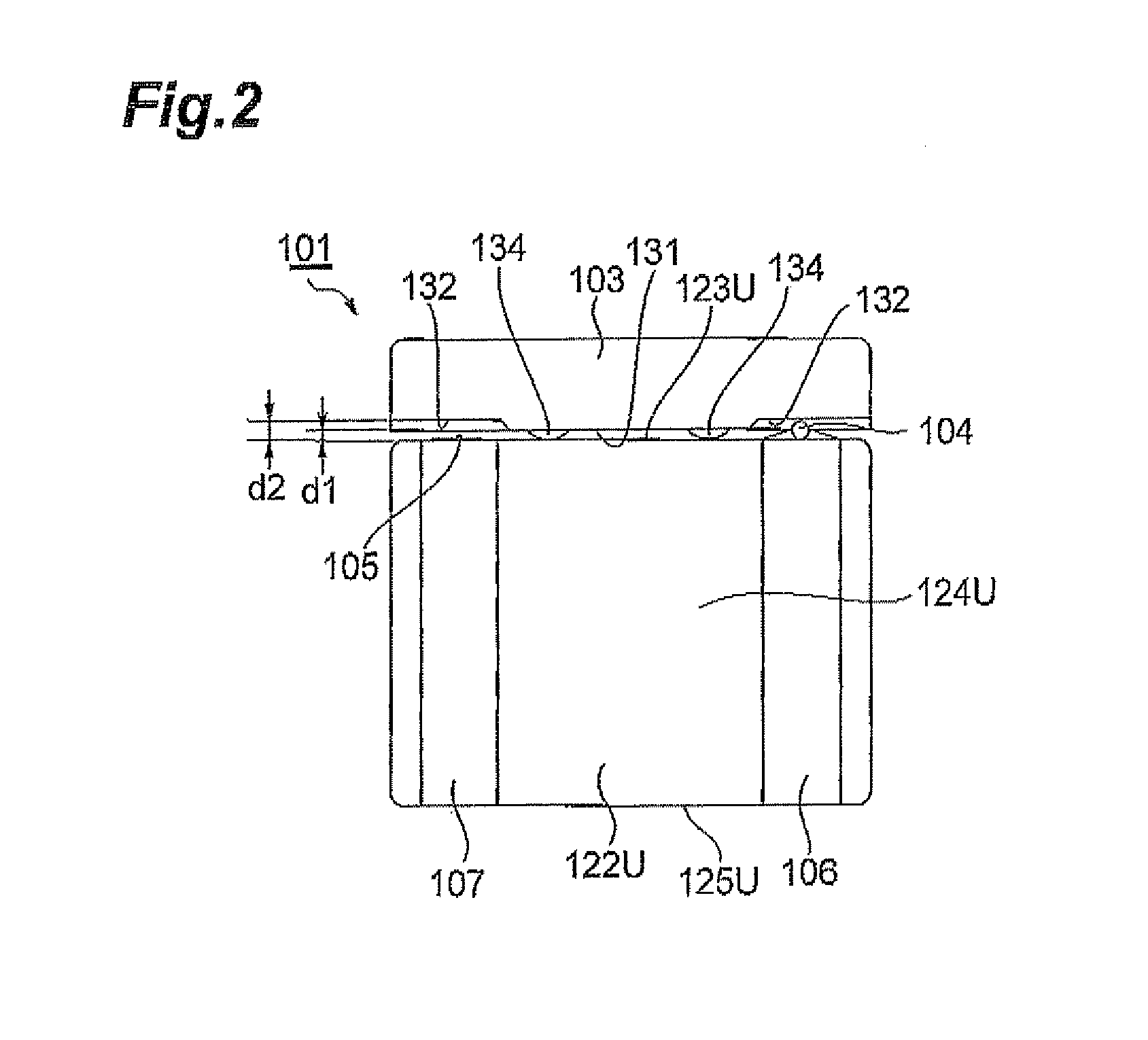transformer
a transformer and transformer technology, applied in transformers/inductance details, transformers/inductance coils/windings/connections, electrical apparatus, etc., can solve the problems of eddy current, mounting failure, deterioration of the surroundings of the electrode connecting portion, etc., to improve the dc superposition characteristic, reduce the stray capacitance, and stabilize the output voltage
- Summary
- Abstract
- Description
- Claims
- Application Information
AI Technical Summary
Benefits of technology
Problems solved by technology
Method used
Image
Examples
second embodiment
[0063]The step-up transformer in accordance with the present invention will now be explained.
[0064]FIGS. 10 to 14 are perspective, front, side, top plan, and bottom plan views of the step-up transformer in accordance with the second embodiment, respectively, while FIGS. 15 to 18 are front, side, top plan, and bottom plan views illustrating the step-up transformer without its plate-like core. FIG. 19 is a circuit diagram of the drum core in accordance with an example.
[0065]The step-up transformer 201A in accordance with this embodiment is used for stepping up the voltage of a strobe light source for a camera, for example, and comprises a drum core 202, a primary winding 203, a secondary winding 204, input terminals 205U, 205L, output terminals 206U, 206L, and a plate-like core 207 as illustrated in FIGS. 10 to 14. Here, the step-up transformer 201A has a length (in the horizontal direction in FIG. 13) of about 3.2 mm, a width (in the vertical direction in FIG. 13) of about 2.5 mm, an...
third embodiment
[0078]The step-up transformer in accordance with the present invention will now be explained.
[0079]FIG. 22 is a sectional view illustrating a main part of the step-up transformer in accordance with the third embodiment of the present invention. This step-up transformer 201B is one in which the primary and secondary windings 203, 204 are wound differently from those in the step-up transformer 201A in accordance with the second embodiment illustrated in FIG. 20.
[0080]In the step-up transformer 201B, the start wire S2 is located at a position adjacent to the flange 222U, each tier of the secondary winding 204 is wound from the flange 222U on one side to the flange 222L on the other side, and the winding end portion of the secondary winding 204 is not directly wound about the winding core part 221.
[0081]In the step-up transformer 201B, the number of turns of the primary winding 203 is smaller than that in the step-up transformer 201A in accordance with the second embodiment, while the w...
fourth embodiment
[0086]The step-up transformer in accordance with the present invention will now be explained.
[0087]FIG. 23 is a sectional view illustrating a main part of the step-up transformer in accordance with the fourth embodiment of the present invention. This step-up transformer 201C is one in which the primary winding 203 is wound differently from that in the step-up transformer 201B in accordance with the third embodiment illustrated in FIG. 22. That is, in the step-up transformer 201C, the winding start portion S1 of the primary winding 203 is located at a position adjacent to the flange 222U on one side, while the primary winding 203 is wound at substantially uniform intervals such that its turns are in no contact with each other.
[0088]In thus constructed step-up transformer 201C, as in the step-up transformer 201A in accordance with the second embodiment, the start wire S2, which is the winding start portion of the secondary winding 204 for the winding core part 221, is covered with the...
PUM
| Property | Measurement | Unit |
|---|---|---|
| thickness | aaaaa | aaaaa |
| height | aaaaa | aaaaa |
| height | aaaaa | aaaaa |
Abstract
Description
Claims
Application Information
 Login to View More
Login to View More - R&D
- Intellectual Property
- Life Sciences
- Materials
- Tech Scout
- Unparalleled Data Quality
- Higher Quality Content
- 60% Fewer Hallucinations
Browse by: Latest US Patents, China's latest patents, Technical Efficacy Thesaurus, Application Domain, Technology Topic, Popular Technical Reports.
© 2025 PatSnap. All rights reserved.Legal|Privacy policy|Modern Slavery Act Transparency Statement|Sitemap|About US| Contact US: help@patsnap.com



